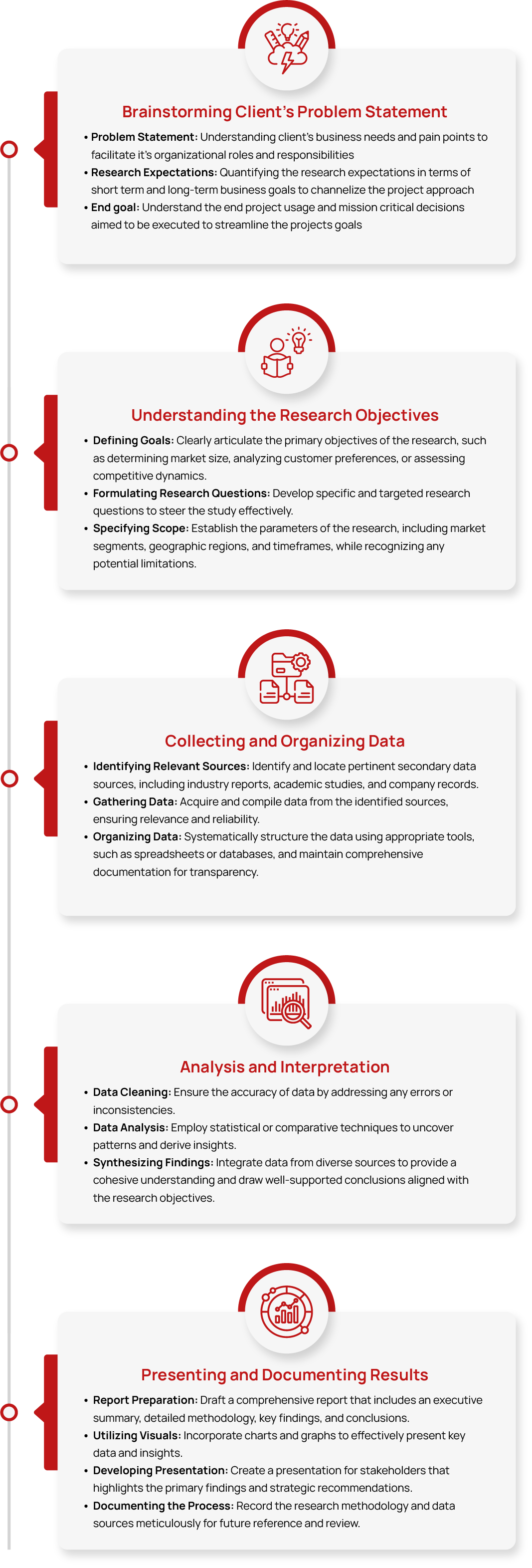Global Precipitated Calcium Carbonate Market Size, Share, Growth & Trend Analysis Report, 2032
- Summary
- Market Landscape
- Methodology
- Table of Content
Global Precipitated Calcium Carbonate (PCC) Market Size, Share, Growth & Trend Analysis Report, By Grade (Pharmaceutical, Industrial), By Application (Pharmaceuticals, Paper, Plastics, Cosmetics, Paints & Coatings, Food & Beverage, and Others), By Region (Asia Pacific, Europe, North America, Latin America and Middle East & Africa) and Forecasts 2024-2032
Precipitated Calcium Carbonate (PCC) is a synthetic form of calcium carbonate that is produced through a controlled chemical precipitation process. It differs from ground calcium carbonate (GCC), which is made by mechanically crushing and grinding natural calcium carbonate deposits.
The Global Precipitated Calcium Carbonate (PCC) Market was valued at USD XX billion in 2024 and is anticipated to reach USD XX billion by 2032, reflecting a compound annual growth rate (CAGR) of around 5% during the forecast period from 2025 to 2032.
Industry Trends
The global precipitated calcium carbonate (PCC) market is driven by increasing demand from industries such as paper, plastics, paints, and adhesives, where precipitated calcium carbonate enhances product quality, performance, and cost-efficiency. In the paper industry, precipitated calcium carbonate is widely used as a filler and coating pigment to improve brightness and smoothness.
Growing environmental concerns and the need for sustainable alternatives also boost precipitated calcium carbonate adoption, as it reduces the reliance on wood-based pulp. Additionally, the expanding construction sector drives demand for precipitated calcium carbonate in paints & coatings.
However, market growth is restrained by high production costs, complex manufacturing processes, and the availability of substitutes like ground calcium carbonate (GCC). Additionally, fluctuations in raw material prices and stringent environmental regulations on carbon emissions pose challenges to manufacturers. Despite these restraints, advancements in nanotechnology and the development of innovative PCC grades create growth opportunities in specialized applications.
TT Consultants’ Perspective
The global Precipitated Calcium Carbonate (PCC) market is experiencing steady growth, driven by its diverse industrial applications and increasing demand for sustainable and high-performance materials. PCC is widely used across industries such as paper, plastics, paints and coatings, pharmaceuticals, food and beverages, cosmetics, and construction.
Asia Pacific, led by countries like China and India, is the fastest-growing region for PCC, fueled by rapid industrialization, increasing construction activities, and the expanding automotive and packaging industries. The ongoing trend towards reducing the carbon footprint in industrial processes is further stimulating demand for PCC, as technologies like SkyCycle™ convert CO2 emissions into valuable products like PCC, contributing to both environmental goals and industrial applications.
Furthermore, innovations in PCC production technologies, such as advancements in morphology and particle size distribution, are enabling better performance in applications such as paints, coatings, and plastics.
Market Segmentation
1. By Grade (Pharmaceutical, Industrial)
The global Precipitated Calcium Carbonate (PCC) market is segmented into pharmaceutical and industrial grades, each serving distinct applications. Pharmaceutical-grade PCC is primarily used in the healthcare industry, particularly for calcium supplements and as an excipient in tablet formulations.
Its demand is driven by the increasing focus on health, aging populations, and growing awareness of calcium deficiency. Additionally, strict regulatory standards ensure the quality and safety of pharmaceutical-grade PCC, further bolstering its market presence.
On the other hand, industrial-grade PCC is widely used across multiple industries, including paper, plastics, paints, coatings, rubber, and construction. It acts as a cost-effective filler and reinforces products, enhancing strength and durability in end-use applications. The growth of the paper, construction, and automotive sectors significantly contributes to the demand for industrial-grade PCC.
However, both grades face challenges, including high production costs, the availability of raw materials, and competition from substitutes like ground calcium carbonate (GCC), which can limit their market share. Despite these restraints, the continued expansion of end-use industries, along with advancements in product innovation, supports the sustained growth of both grades.
2. By Application (Pharmaceuticals, Paper, Plastics, Cosmetics, Paints & Coatings, Food & Beverage, and Others)
The global Precipitated Calcium Carbonate (PCC) market is broadly categorized by application, including pharmaceuticals, paper, plastics, cosmetics, paints & coatings, food & beverage, and others, each driving distinct demand trends. In pharmaceuticals, PCC is used as a calcium supplement and excipient, particularly in tablet formulations. Its demand is fueled by the growing health-conscious population and aging demographics, alongside rising health awareness.
The paper industry is a significant user of PCC, where it serves as a filler and coating material to enhance brightness, opacity, and smoothness, supporting the market’s growth in this sector. In plastics, PCC is utilized as a reinforcing filler, enhancing product strength, reducing material costs, and improving performance in various plastic products.
The cosmetics industry also drives PCC demand, using it in formulations for skincare and personal care products due to its gentle abrasive and texturizing properties. Paints and coatings applications account for a large portion of the PCC market, where it improves product opacity, texture, and consistency. In the food and beverage industry, PCC is used as an additive, specifically in processed foods, where it serves as a stabilizer, anti-caking agent, or nutritional supplement.
The others category includes various niche applications, such as adhesives, sealants, rubber, and construction materials, further diversifying the market. Despite the wide array of applications, challenges such as raw material availability, production costs, and regulatory compliance impact the market's overall growth. However, the diverse use across industries continues to drive PCC demand.
3. By Region (North America, Europe, Asia Pacific, Latin America, Middle East Africa)
In North America and Europe, the Precipitated Calcium Carbonate (PCC) market is well-established, driven by demand from industries such as paper, plastics, paints, and coatings. In North America, particularly in the United States, PCC is widely used in the manufacturing of paper products, plastic reinforcement, and paint formulations, benefiting from a strong industrial base and focus on sustainability.
Similarly, in Europe, countries like Germany and Italy see significant use of PCC in automotive, plastics, and construction applications, with a growing emphasis on eco-friendly and performance-enhancing materials. Both regions are characterized by mature markets with high demand for specialized grades of PCC and a strong inclination toward innovative and sustainable solutions.
In Asia Pacific, Latin America, and Middle East & Africa, the PCC market is experiencing varied growth. Asia Pacific, led by countries like China and India, is the fastest-growing region, driven by rapid industrialization, expanding construction and automotive sectors, and increasing demand from the paper industry.
In Latin America, demand is stable, particularly from the paper and packaging industries in Brazil and Mexico, while Middle East & Africa see gradual growth, with a focus on the construction sector. These regions, while not as mature as North America and Europe, are projected to experience steady growth as industrialization and urbanization continue to rise, expanding the demand for PCC across various applications.
Competitive Scenario
Key players in the market include Cales de Llierca SA, Carmeuse Coordination Center SA, Chemical and Mineral Industries Pvt. Ltd., FIMATEC Ltd., GCCP Resources Ltd., Graymont Ltd, Guangdong Qiangda New Materials Technology Co. Ltd., Gulshan Polyols Ltd., Imerys S.A., Lhoist SA, Longcliffe Quarries Ltd., Minerals Technologies Inc., Mississippi Lime Co., Nordkalk Corp., Okutama Industry Co. Ltd., Omya International AG, SCHAEFER KALK GmbH and Co. KG, SCR Sibelco NV and Shiraishi Kogyo Kaisha Ltd among others
These competitors leverage their global presence, strong distribution networks, and established customer relationships to stay ahead of regional competitors. They invest heavily in research and development (R&D) to improve product quality, innovate new PCC applications, and offer sustainable and environmentally friendly solutions, such as PCC produced using carbon dioxide capture technologies.
Recent Developments and Strategic Activities:
- Calcium Carbonate (GCC) and Precipitated Calcium Carbonate (PCC) in Asia, with seven new plants under construction in China and Indonesia. The plants, located in Guangxi, Guangdong, Shandong, and Fujian in China, and Sumatra in Indonesia, will have a combined capacity of approximately 1 million tons per year, including 740,000 tons of GCC and 260,000 tons of PCC. These facilities have commissioned between 2023 and 2024 and will serve as key suppliers for the board and paper industry.
- In February 2023, CarbonFree and bp have partnered to deploy CarbonFree’s SkyCycle™ technology at hard-to-abate industrial sites, capturing CO2 emissions and converting them into Precipitated Calcium Carbonate (PCC). This collaboration aims to accelerate the commercialization of SkyCycle™, helping industries decarbonize while producing high-value PCC for various industrial applications, such as in paper, plastics, and coatings.

Please fill out the form to request the ToC and gain access to detailed insights in the report.
Request Table of Contents







